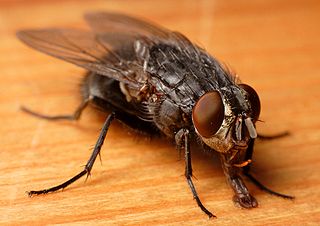
Nanorana vicina is a species of frog in the Dicroglossidae family. It is found in the Himalayan front of northern India and Pakistan. Its natural habitats are high-altitude rivers, springs, and other running water in open forest and grassland habitats. There seem not to be any major threats to this species.
The Tagula honeyeater is a species of bird in the family Meliphagidae. It is endemic to Papua New Guinea.

Calliphora vicina is a member of the family Calliphoridae, which includes blow flies and bottle flies. These flies are important in the field of forensic entomology. C. vicina is currently one of the most entomologically important fly species because of its consistent time of arrival and colonization of the body following death.
Euphaedra vicina, or the glossy white-striped forester, is a butterfly in the family Nymphalidae. It is found in Nigeria, Cameroon, the Democratic Republic of the Congo and Uganda. The habitat consists of forests.

Vicina was a town on the Danube used as a tradepost (Emporia) by the Republic of Genoa, being part of the Genoese trade empire between the 13th and 14th century. At one time, it was the most flourishing port of the maritime Danube, but its importance declined with the development of other ports such as Kilia and Brăila. Although many locations have been proposed by both historians and archeologists as the remains of Vicina, it is still unknown where this town was located.
Caradrina vicina is a moth of the family Noctuidae. It was described by Staudinger in 1870. It is found from central Italy east to Bulgaria, southern Russia, eastern and central Turkey, Israel and Lebanon and from Iran to Central Asia. The habitat consists of grasslands.
Agelaia vicina is a species of wasp in the genus Agelaia. They are neotropical social wasps known to have the largest colony sizes and nest sizes among social wasps, with some colonies exceeding over one million individuals. They are predators of land arthropods, consuming both insects and spiders alike. Recent sperm morphology studies have shown that although Vespidae belong to the superfamily Vespoidea, Agelaia vicina may be more phylogenetically related to Apoidea.
Phrissomini is a tribe of longhorn beetles of the Lamiinae subfamily. It was described by Thomson in 1860.
Pseudostixis is a genus of longhorn beetles of the subfamily Lamiinae, containing the following species:
Pseudostixis densepunctata is a species of beetle in the family Cerambycidae. It was described by Stephan von Breuning in 1936.
Pseudostixis griseostictica is a species of beetle in the family Cerambycidae. It was described by Stephan von Breuning in 1936.
Pseudostixis marshalli is a species of beetle in the family Cerambycidae. It was described by Stephan von Breuning in 1936.
Pseudostixis proxima is a species of beetle in the family Cerambycidae. It was described by Stephan von Breuning in 1936.
Pseudostixis basigranosa is a species of beetle in the family Cerambycidae. It was described by Stephan von Breuning in 1945.
Pseudostixis basilewskyi is a species of beetle in the family Cerambycidae. It was described by Stephan von Breuning in 1960.
Pseudostixis flavomarmorata is a species of beetle in the family Cerambycidae. It was described by Stephan von Breuning in 1964, originally as Pseudostixis flavomarmoratus. It is known from the Democratic Republic of the Congo.
Pseudostixis integra is a species of beetle in the family Cerambycidae. It was described by Stephan von Breuning.
Pseudostixis dentata is a species of beetle in the family Cerambycidae. It was described by Hintz in 1911.
Pseudostixis flavifrons is a species of beetle in the family Cerambycidae. It was described by Aurivillis in 1914, originally under the genus Stixis.




